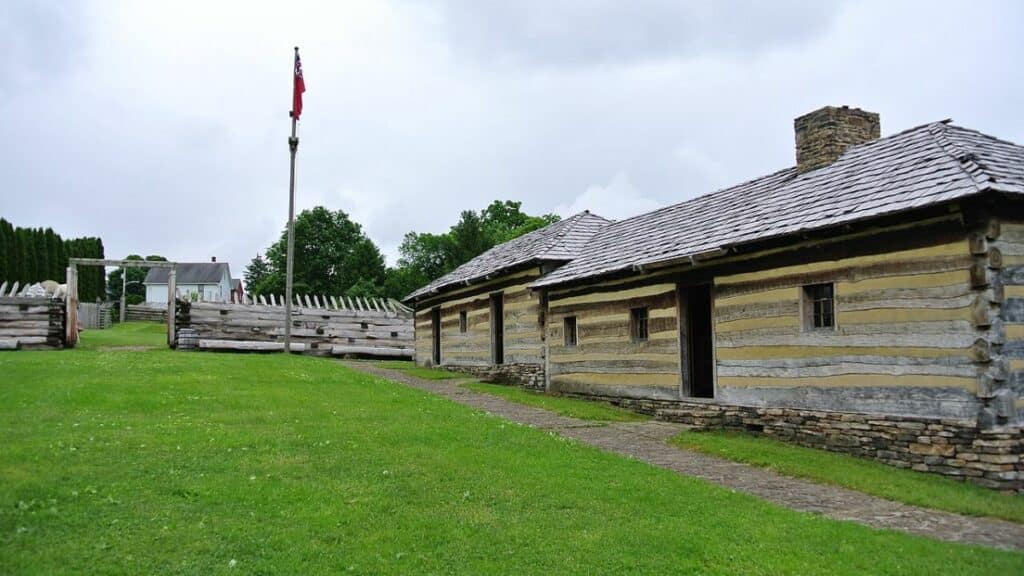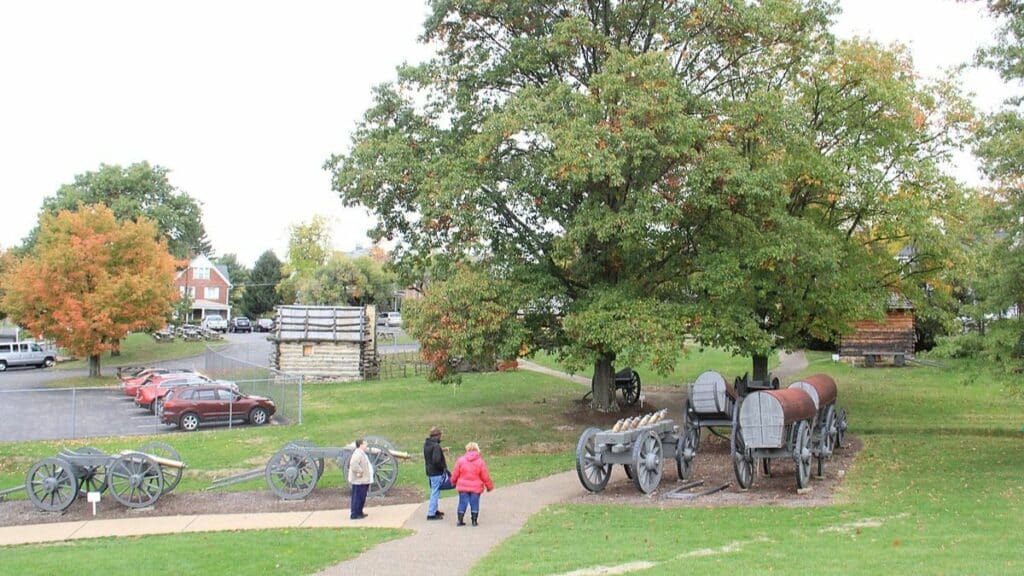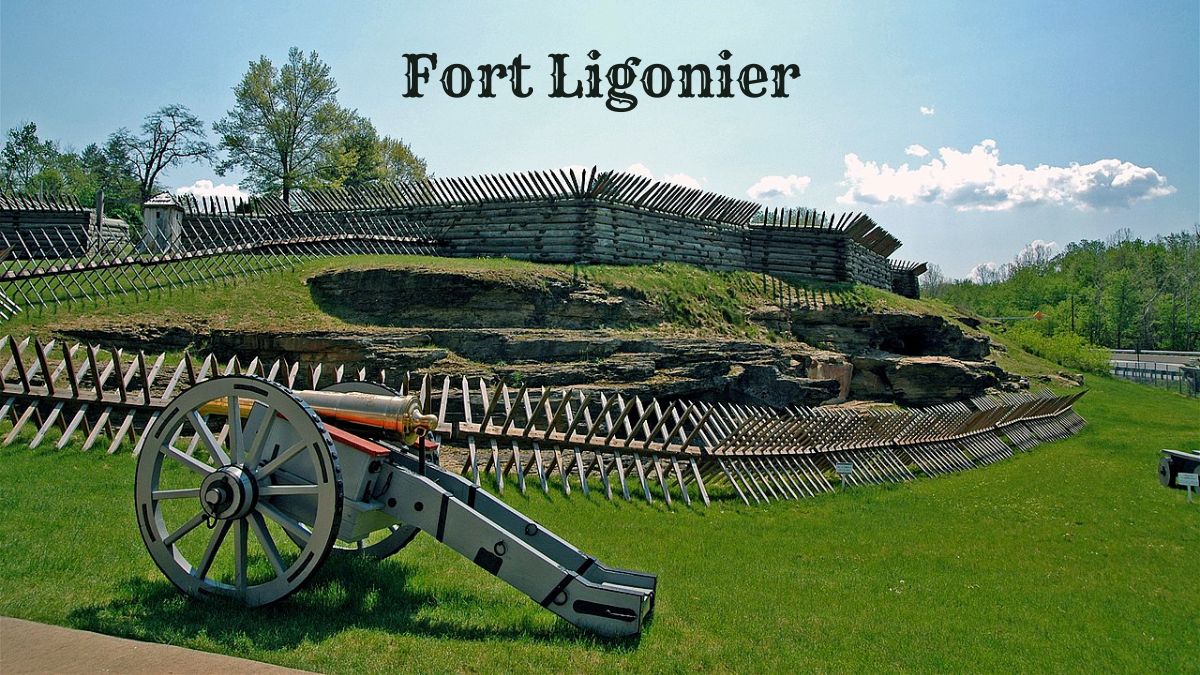Fort Ligonier is a captivating piece of history, offering visitors a detailed glimpse into the French and Indian War. Located in Ligonier, Pennsylvania, this well-preserved fort and museum provide an educational and engaging experience for all ages.
Fort Ligonier’s comprehensive exhibits and interactive displays allow visitors to explore the military strategies and daily life of the 18th century.
Lush landscapes surround Fort Ligonier, inviting guests to walk through its reconstructed buildings and battlements.
The meticulously maintained grounds transport you back to when the fort was critical in early American history.
The fort’s collection includes original artifacts, cannons, and detailed dioramas that bring the past to life.
Participating in one of the many live reenactments or guided tours further enriches the experience at Fort Ligonier.
History and Background of Fort Ligonier

Fort Ligonier played a significant role during the French and Indian War. It was strategically located to command the roads leading to the frontier.
Prominent figures like General John Forbes and George Washington contributed to its history, particularly during the Battle of Fort Ligonier.
French and Indian War Origins
The French and Indian War, part of the broader Seven Years’ War, was driven by the competition between France and Britain to control North America. Both powers established a series of forts to assert territorial claims.
Fort Ligonier was constructed under British command to counter French forces and prevent their advances into the Ohio Valley region.
Strategic Importance of Fort Ligonier
Fort Ligonier’s location near the Forks of the Ohio River made it crucial for controlling movement and supply routes.
It was a central point for British operations, providing a defensive stronghold against French and Native American forces.
Its robust design and fortifications allowed it to withstand sieges and became a critical node in the British military network.
The Role of General John Forbes
General John Forbes was instrumental in Fort Ligonier’s construction and operational planning.
He led the Forbes Expedition, which aimed to capture Fort Duquesne from the French.
Forbes implemented a careful and methodical strategy, including constructing a series of supply forts. This culminated in establishing Fort Ligonier as a key logistical and military hub.
Battle of Fort Ligonier
The Battle of Fort Ligonier occurred on October 12, 1758, and involved an attack by French and Native American forces.
Despite a fierce engagement, the British garrison held firm, thanks to strong leadership from Colonel Henry Bouquet and the fort’s strategic defenses.
This victory boosted British morale and paved the way for the eventual capture of Fort Duquesne.
Fort Features and Layout

Fort Ligonier showcases strategic design and efficient supply systems, making it a key defensive structure.
Design and Construction of the Fort
Fort Ligonier, built under the direction of General John Forbes, was designed to protect British interests in the region.
The fort consisted of a series of bastions and redoubts designed to provide maximum defensive coverage.
The fortification included a wooden stockade surrounding the central compound, reinforced with earthen walls.
The layout featured a central parade ground, powder magazines, storehouses, and barracks.
The fort’s design was somewhat influenced by earlier fort designs involving British and colonial engineers. The engineers also took strategic advice from George Washington, who had regional experience.
Cannons and Defense
Cannons placed along the bastions played a crucial role in the fort’s defense.
These artillery pieces varied in size and power, capable of deterring enemy advances and providing support fire.
The strategic placement of cannons allowed defenders to cover all potential approaches to the fort.
The fort also had smaller artillery, including swivel guns, to defend against close-range infantry attacks.
Defensive measures included a glacis—an earthen slope descending from the fort walls to make enemy assaults more difficult.
These defenses were continuously improved upon the commission to ensure the fort remained impregnable.
Wagons and Supply Lines
Wagons were essential for transporting supplies to Fort Ligonier.
Given its remote location, maintaining a steady flow of resources was vital.
Supply lines extended from various British-held territories, with regular convoys transporting food, ammunition, and other necessities.
The commissary officers managed the logistics, ensuring the timely arrival of supplies and reinforcements.
The success of these operations was significant for sustaining the fort’s defenses, and the coordination was often attributed to the effective leadership skills fostered within the fort’s rank and file.
Museum and Exhibitions

The museum at Fort Ligonier traces the fort’s rich history, showcases artifacts and paintings, and offers special events.
It features permanent galleries filled with historic displays, unique artifacts, and paintings that depict significant moments.
Permanent Galleries
The permanent galleries are designed to provide a comprehensive look at the history of Fort Ligonier.
Each gallery holds displays that educate visitors about 18th-century military life, the fort’s role in the French and Indian War, and the daily existence of the soldiers and civilians who occupied it.
Interactive exhibits and audiovisual displays enhance the learning experience. Key highlights include detailed maps, military uniforms, and weaponry.
These galleries allow guests to immerse themselves in the era and gain a deeper appreciation for the fort’s historical significance.
Artifacts and Paintings
The museum boasts a significant collection of artifacts and paintings that bring the past to life.
Items on display include original muskets, cannons, and soldiers’ personal belongings. Each artifact is meticulously preserved to maintain its historical integrity.
Paintings in the museum capture important events and figures related to Fort Ligonier.
Portraits of notable military leaders and battle scenes provide visual context.
The artwork effectively supplements the historical narratives, adding depth to the stories told within the museum walls.
Special Programs and Events
Fort Ligonier Museum offers a variety of special programs and events throughout the year.
These events often include historical reenactments, educational workshops, and lectures from historians.
For example, on Thanksgiving weekend, the museum hosts unique, family-friendly programs that attract visitors of all ages.
Interactive activities, such as weapon demonstrations and guided tours, provide hands-on learning opportunities.
Annual camps and events are specifically designed for children, making history engaging and accessible to the younger audience.
These programs ensure that there is always something new and informative for repeat visitors.
Explore More: 10 Historic Forts in Pennsylvania: Bastions of Time Past
Operating Hours and Admission
Fort Ligonier’s operating hours may vary throughout the year:
- March – April: Open Wednesday through Sunday, 10 AM – 5 PM.
- May – October: Open daily, 10 AM – 5 PM.
- November: Open Wednesday through Sunday, 10 AM – 4 PM.
- December: Open Friday through Sunday, 10 AM – 4 PM.
Note: The Fort is closed on major holidays such as Thanksgiving Day, Christmas Eve, Christmas Day, New Year’s Eve, and Easter Sunday.
Admission Fees
- Adults: $10.00
- Seniors (60+): $8.00
- Students (13-17): $6.00
- Children (6-12): $5.00
- Children (under 6): Free
- Families: $25.00 (Includes 2 adults and up to 3 children)
Annual Preservation Work
Certain sections of the fort may be temporarily closed for annual preservation work. Please check in advance.
Inclement Weather
In inclement weather, Fort Ligonier may close or adjust its hours.
Visitors are advised to check the official website or call ahead before planning their visit.
Preservation and Legacy
Fort Ligonier is a pivotal reminder of early American history, meticulously preserved to educate and inspire visitors about the past.
National Register of Historic Places
Fort Ligonier is recognized in the National Register of Historic Places, emphasizing its importance in American history.
This status helps protect the site and promotes awareness and appreciation of its historical value.
The fort has undergone careful restoration to maintain its original structure and features.
It includes replicated buildings, stockades, and artillery pieces, faithfully reconstructed from historical records.
These measures ensure that Fort Ligonier remains an authentic and educational visitor experience.
Revolution to Present-Day
During the American Revolution, Fort Ligonier played a crucial role as a supply depot and strategic military post.
Its significance continued to be acknowledged as the United States grew.
The fort was gradually restored over the years to reflect its appearance during the 18th century.
This restoration provides a tangible connection to the era, allowing visitors to visualize and understand the fort’s role in American history.
Today, Fort Ligonier serves as a historical site and a center for education and cultural events, attracting thousands of visitors annually.
Annual Preservation Initiatives
Annual Preservation Work supports Fort Ligonier’s preservation.
These initiatives are essential for maintaining the fort’s condition and historical accuracy.
Efforts include structural repairs, artifact restoration, and ongoing archaeological research.
Events like Winter Weekends offer special programs and activities to engage the public and foster a deeper connection to the fort’s history.
These initiatives ensure that Fort Ligonier continues to educate and inspire future generations, preserving its legacy as an important historical landmark.
Location and Visitor Information
Fort Ligonier is situated in Ligonier, Pennsylvania, a picturesque town known for its rich history.
The fort lies approximately 50 miles east of Pittsburgh, easily accessible via Route 30.
Nestled in the Laurel Highlands, this location offers a scenic backdrop and numerous outdoor activities.
Address:
200 S Market St,
Ligonier, PA 15658
Operating Hours:
- Monday to Saturday: 9:00 AM – 5:00 PM
- Sunday: 12:00 PM – 5:00 PM
Admission tickets are reasonably priced, with discounts available for seniors, students, and children.
Groups are welcome, and educational tours can be arranged in advance.
Admission Prices:
- Adults: $12.00
- Seniors (65+): $10.00
- Students: $10.00
- Children (6-17): $6.00
- Children under 6: Free
Visitors can enjoy exhibits, guided tours, and interactive demonstrations that provide insight into the fort’s role during the French and Indian War.
Website:
For more details and to purchase tickets online, visit the official website.
Parking is conveniently available on-site, with spaces for buses and larger vehicles.
The fort also provides accessibility features to ensure all visitors have an enjoyable experience.
Fort Ligonier in Popular Culture
Fort Ligonier, a notable historical site, has left its mark in various cultural arenas, including literature, film, and museum exhibits. These representations highlight the fort’s significant role during the French and Indian War.
Literature and Film
Fort Ligonier has appeared in historical accounts and fictional narratives in literature.
Edward P. Zeman’s novel Fort Ligonier and its Defenders examines the fort’s strategic importance.
Authors like Michael A. Keller, who focused on its military history, also mention the fort.
In film, the PBS documentary “The War That Made America” features Fort Ligonier.
This documentary showcases re-enactments of significant battles and events at the site, aiding in public historical education.
The World Ablaze Exhibit
Fort Ligonier is also featured in various exhibitions, notably The World Ablaze. This exhibit provides a detailed account of the fort’s history and the broader conflict of which it was a part.
Visitors encounter artifacts, interactive displays, and informative panels. The exhibit emphasizes the contributions of key figures, such as the Marquis de Lafayette, who played vital roles during the French and Indian War.
Interactive elements: Interactive exhibits include digital maps and augmented reality experiences.
These make history accessible and engaging for all ages while maintaining historical accuracy. Such technology helps bring the past to life for modern audiences.

Cory is a website owner and content creator who enjoys fishing, history, coin collecting, and sports, among other hobbies. He is a husband and father of four.
Romans 15:4 For whatever was written in former days was written for our instruction, that through endurance and through the encouragement of the Scriptures we might have hope.

